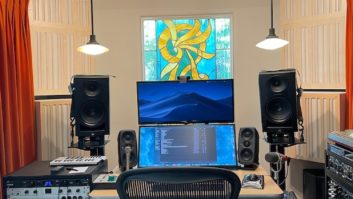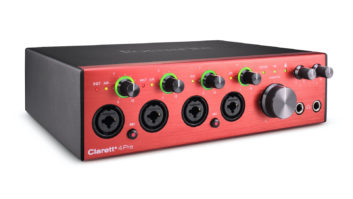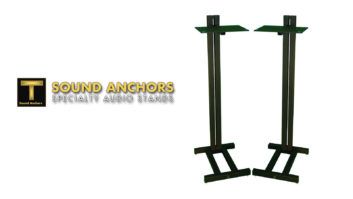
Orpheus’ front panel with assignable rotary control, two headphone outputs and meter panel. The rear panel is packed with I/O including mic/line, S/PDIF/AES, word clock, FireWire and Lightpipe.
Prism Sound has been making high-performance, no-compromise pro audio production and test/measurement gear for 21 years. The company’s latest offering is Orpheus — a multichannel Mac/Windows AD/DA FireWire interface with mic preamps and built-in software mixer that can perform as a DAW front-end or as a stand-alone converter or mic preamp. While this genre of product is nothing new, Prism Sound sought to bring its pedigree and vision into the world of the “all-in-a-box” FireWire interface.
Orpheus delivers eight AD/DA converters, four mic preamps, two instrument inputs, MIDI I/O, word clock I/O and other expected fare. However, what sets Orpheus apart from standard DAW interfaces are its interesting extras, such as RIAA equalization on inputs 1/2, an M/S decoder, an excellent software interface and high-end features that are found in Prism’s other products.
In the Beginning
I tested Orpheus using Cakewalk SONAR Version 7.02 on a 32-bit Windows Vista machine powered by a 3GHz Intel Core Extreme CPU Q6850 with 4 GB of RAM, and with Apple Logic Pro V. 8.0.2 on a MacBook 2.16 GHz Intel Core 2 Duo with 1 GB RAM running OS X 10.5.4. Initial setup was easy; thanks to Orpheus’ latest audio driver/control panel, V. 1.04, ASIO and WDM drivers communicate with Windows XP or Vista 32-bit systems, while OSX 10.4 or later interfaces directly with Core Audio. Once configured, the settings are stored within non-volatile memory, which allows Orpheus to operate independently of the host computer.
Twin FireWire 400 ports provide host connectivity and allow you to daisy-chain up to six units within a 48kHz sample rate (three units at 96 kHz and one unit at 192 kHz). Digital connectivity is via software-selectable coaxial RCA and optical Toslink connectors. The coaxial I/O is capable of 2-channel S/PDIF audio from 44.1 to 192k Hz and AES3 (AES/EBU) format using the supplied RCA-XLR adapter. The optical port offers 2-channel S/PDIF, 8-channel ADAT protocol (44.1 to 48 kHz) or 4-channel S/MUX format at 88.2/96kHz rates. Dual channel S/PDIF input and output signals can route through Orpheus’ onboard sample-rate converter — a great stand-alone option for up- or down-conversion of sample rates in stereo mixes.
Four combo XLR/TRS jacks handle mic/line inputs for channels 1 to 4, while channels 5 to 8 are TRS (line only). The eight analog outputs are ¼-inch TRS. All have switchable +4dBu/-10dBV sensitivity and accept balanced or unbalanced signals. The preamps feature switchable phantom power, 10- to 65dB gain (adjustable in 1dB steps) and an M/S matrix within the Orpheus Control Panel. Additionally, channels 1/2 have front panel, high-impedance DI inputs and an RIAA de-emphasis filter for turntables.
The front panel has two headphone outs with individual volume pots and a large assignable rotary control that’s useful for stereo or surround monitor control. On the metering panel are eight plasma-style meters (switchable to display the eight analog inputs or outputs) and two for the S/PDIF channels.
In Session
I first used Orpheus to record a Fender Jazz Bass patched into the front panel DI. As I adjusted the gain, I noticed the onboard meters provided only a presence-style metering, while the software Control Panel provided numerical results, which are much more accurate. The 24-bit/96kHz SONAR 7 session yielded a recording with clear string definition and a robust low end. Here, I tried Orpheus’ Overkiller feature, a progressive limiter switchable across any and all eight inputs (the same used on Prism’s ADA-8XR converter). I set the bass gain a little hotter than the previous recording, purposely recording digital overs. The results were as expected, with truncated waveforms and bits of distortion. With the same gain setting, I repeated the next take using Overkiller and it worked as promised, protecting against overloads up to a margin of 10 dB. Playback exhibited a big low-end while the slap transients were absorbed and rounded off.
Another SONAR 7 session at 24-bit/192kHz offered sonic bliss but was a bit sketchy in the stability department. Control Panel buffer time was set to 5,000 microseconds (or 5 ms) and latency set to 15 ms. I fed a SONAR 7 virtual instrument, Session Drummer 2, to Orpheus’ Control Panel along with an acoustic guitar miked with an AKG 451E that I patched in. Working within the Control Panel, I engaged phantom power and an 80Hz highpass filter. I had a cue mix up in no time but randomly experienced a loss of communication between the Orpheus and SONAR. To fix this, I simply saved the session and re-launched the DAW. The tracks quickly revealed the combination of the 451E, Orpheus’ mic preamps and SONAR, yielding an excellent recording.
The acoustic guitar sounds naturally sweet in the midrange around 1 to 4k Hz, and the Orpheus mirrored its sound perfectly. The tracks represented the guitar’s pick attack and its incredibly open top-end very well. The recording did produce a few digital snats, but another overdub using an increased latency time of 25 ms gave me a glitch-free recording. Because Orpheus’ mixes are established within its hardware and zero latency, the cue mix felt tight and sounded great, even with increased software latency settings.
A later mixdown session involved a Pro Tools HD 7.4 system feeding an SSL 4056G+ desk. The Pro Tools HD system used three Apogee Rosetta 800 converters that were clocked off an Apogee Big Ben Master Clock. The SSL’s stereo bus, which was placed after its Quad Bus compressor, was patched back into a stereo audio track in Pro Tools for the final print. For comparison, I patched the same mix from the SSL into the Orpheus. This time the Orpheus was connected to a MacBook running Logic 8; both platforms were running at 24-bit/88.2 kHz. I took the two different prints back to my studio, imported them back into Pro Tools HD 7.4, which was interfaced with a Mytek Digital 8×192 AD/DA and compared. On playback, both prints sounded great, revealing only slight differences. The top end on the Orpheus mix (above 12 kHz) was very open, without a hint of harshness or digital smear. The critical midrange sounded excellent on the Orpheus; the snare drum exhibited the biggest difference between the two units. On the mix that was converted on the Rosettas, the snare sound a little dull around the 200-240 Hz region, which wasn’t the case with the Orpheus. The bottom snares sounded more pronounced on the Orpheus, due to its more-detailed top-end. The more I listened, the easier it was to pick out the Orpheus mix, including its better depth of field and wider stereo image. I felt that the Orpheus’ mix better reflected the final SSL desk mix.
Finally, I compared the Orpheus, a Mytek Digital 8×192 AD/DA and the Rosetta 800/Big Ben combination. I played a stereo mix from an Alesis Masterlink’s analog outs into patchbay mults and fed the result directly into all three converters. Other than the converters, the mix’s path was all-wire between the units and my ears.
With all three systems clocking at 192 kHz, the Orpheus and the Mytek performed in an incredibly similar manner, with the Orpheus pushing forward just a bit around the 7 to 9kHz range. In both units, the stereo imaging was spot-on. The Rosetta displayed an image shift (narrowing) and a bit of strident honkiness in the midrange along with a bump around 400 Hz. I was interested in how the Orpheus would react with its Overkiller feature in the circuit. With the sample rate at 96 kHz and a slightly hotter mix, the Orpheus produced a slightly louder vocal and guitar compared with the Mytek, with the Rosetta reflecting similar results as the previous 192kHz test. This is certainly a subjective test, and the Mytek and the Orpheus were excellent contenders, but when compared to the original source material, I felt Mytek edged away with the gold.
Greek Myth or Modern Marvel?
Orpheus is a great single-box I/O solution with some nice added extras. The RIAA equalization, Overkiller circuit, M/S matrix and ability to convert sample rates in a stand-alone fashion takes it beyond your average desktop DAW interface. Its build quality is solid and the mic preamps are unbiased and clean — excellent for sources that are highly dynamic and detail-oriented. The software Control Panel is one of the best that I’ve ever used, with a clean GUI and great metering. Even though I lost communication a couple times with SONAR 7 during a 192kHz session using Vista, the ASIO FireWire drivers performed well, and Logic Audio 8 just loved the Orpheus. The recordings that I made using SONAR 7 and the Orpheus were effortless and sounded excellent.
Although pricey at $5k, Orpheus’ extra features and sonic excellence justify the tab. Anyone looking for a high-end FireWire interface should give the Orpheus an audition.
Tony Nunes is a consultant and engineer, and builds a lot of his own gear.








